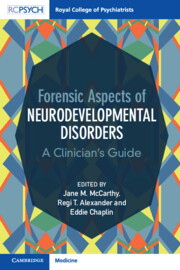Book contents
- Forensic Aspects of Neurodevelopmental Disorders
- Forensic Aspects of Neurodevelopmental Disorders
- Copyright page
- About the Cover Page
- Contents
- Contributors
- Foreword by the Rt Hon Lord Bradley
- Terminology Used in the Book
- Section 1 An Overview: Definitions, Epidemiology and Policy Issues
- Section 2 Assessment and Therapeutic Approach
- Chapter 11 Attention Deficit Hyperactivity Disorder: Assessment and Therapeutic Approaches within Forensic Settings
- Chapter 12 Autism Spectrum Disorder: Assessment and Therapeutic Approaches within Forensic Settings
- Chapter 13 Intellectual Disability: Assessment and Therapeutic Approaches within Forensic Settings
- Chapter 14 Risk Assessments in People with Neurodevelopmental Disorders
- Chapter 15 Assessment and Treatment of Young Offenders
- Section 3 Criminal Justice Pathways and Legal Issues
- Index
- References
Chapter 15 - Assessment and Treatment of Young Offenders
from Section 2 - Assessment and Therapeutic Approach
Published online by Cambridge University Press: 18 May 2023
- Forensic Aspects of Neurodevelopmental Disorders
- Forensic Aspects of Neurodevelopmental Disorders
- Copyright page
- About the Cover Page
- Contents
- Contributors
- Foreword by the Rt Hon Lord Bradley
- Terminology Used in the Book
- Section 1 An Overview: Definitions, Epidemiology and Policy Issues
- Section 2 Assessment and Therapeutic Approach
- Chapter 11 Attention Deficit Hyperactivity Disorder: Assessment and Therapeutic Approaches within Forensic Settings
- Chapter 12 Autism Spectrum Disorder: Assessment and Therapeutic Approaches within Forensic Settings
- Chapter 13 Intellectual Disability: Assessment and Therapeutic Approaches within Forensic Settings
- Chapter 14 Risk Assessments in People with Neurodevelopmental Disorders
- Chapter 15 Assessment and Treatment of Young Offenders
- Section 3 Criminal Justice Pathways and Legal Issues
- Index
- References
Summary
The chapter explores the central challenge of balancing the reduction of recidivism with the need to address the health, educational, identity, family and social care needs of young offenders. It works to summarise the wealth of practical guidance generated in the past decade; considerations of the environment used for assessment and treatment, the attributes and skills of the practitioners working with young offenders and the standardised tools available to ensure that the needs of young offenders are fully understood. The chapter details the wide range of potential unmet needs that young offenders may have; the higher than typical mental health problems, substance use and physical health needs. The context of the pandemic and the importance of the Black Lives Matter movement run through this work and are interwoven with other key identity issues including gender and sexuality. Finally, the chapter summarises treatment approaches, and models of care across the transition interfaces of secure and community settings and child and adult services, while considering the challenge of supporting young offenders in the context of digital spaces and social media.
Keywords
- Type
- Chapter
- Information
- Forensic Aspects of Neurodevelopmental DisordersA Clinician's Guide, pp. 179 - 190Publisher: Cambridge University PressPrint publication year: 2023



